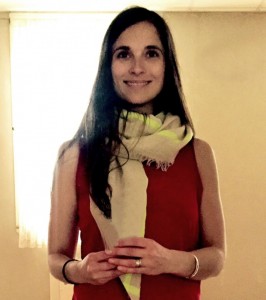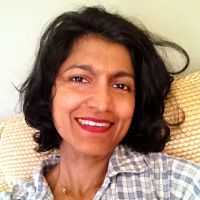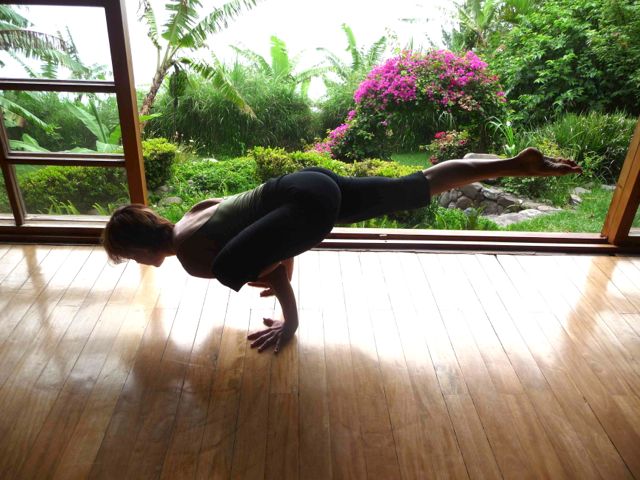SEASONAL SELF-CARE BLOG
Q & A with Annie Kunjappy
Posted on October 14th, 2015
Annie Kunjappy was born and raised in Malaysia by immigrant parents from Kerala, India. She has been in New York since 2004, spreading her knowledge and love for food and conscious eating. Annie will be leading the food portion of our Seasonal Self-Care workshops on November 1 (Winter Wellness) and April 3 (Spring Detox).
How do you know Leigh?
Leigh was my first yoga teacher! She started teaching her first yoga class at the warehouse loft space where I lived in San Francisco in 1990. I feel that her amazing teaching laid a strong foundation for my yoga practice in the years to come. We were both artists in the theater/dance/ performance world and have collaborated on several projects over the years.
Have you always been interested in food? When did you realize you would have a career as a chef?
My mother was a fabulous cook, so I had the good fortune of growing up eating very good food! I have always loved delicious, creative food, but my specific interest in food and healing came about from my own investigations into healing myself from eczema and other sensitivities that had plagued me since childhood. Western doctors at that time offered very little beyond steroids and cortisol creams as salves for the symptoms. My “return” to Eastern medicine and particularly to discovering the power of the daily practice of conscious eating was what finally healed me. This lead me to getting trained as a chef specializing in food and healing.
You studied and taught at the Natural Gourmet Institute for Health and Culinary Arts. How did you decide on that specific program? What was it like going from student to instructor?
The Natural Gourmet Institute offered a program that included the study of Ayurveda, Chinese 5-phase Theory, Macrobiotics, etc. Their approach to gourmet cooking had, at its heart, a devotion to health and healing.
Your approach to to nutrition and self-care is based on Ayurveda, Chinese Medicine and western nutritional science. Can you explain how you integrate all of these “systems” into one?
Each tradition has fine-tuned it’s approach based on the truths of their environment, culture, history and value system. They have their differences and underlying similarities. I do not integrate all these systems into one by any means. Each person, under their specific set of conditions will ideally learn to address their own physical and spiritual needs informed and aided by the richness offered by these various approaches.
What can people expect from your upcoming seasonal attunement workshops? Is it accessible to people who have not been exposed to ayurevda, chinese medicine and seasonal practices?
It is designed to be accessible to the newcomer with plenty of inspiration for further study and investigation. There will be very do-able recipes and easy to follow charts, etc. to take home and start your own practice.
New Yorkers tend to be perfectionists. Is there a way to eat “perfectly” for the seasons? How would you suggest people approach a seasonal diet?
With a keen sense of listening to your own body, curiosity, and flexibility.
When you eat in alignment with the seasons, how do you feel?
Vital, energetic, strong, healthy. Not suffering from overheating in the summer, nor freezing in the winter. There is a sense of flow and ease.
You are also a performer. Do your two passions ever intermingle?
There have been a few shows that included the eating of cupcakes, the cooking and consuming of food on stage, and recipes… And I try to bring my performance background into my workshops, with the hope of making them fun and inspiring…
What do you like to do in your free time?
Hmmm….. “free time”? Time is time for me… I write and paint and read and do fun things with my family and friends….
If you could go anyplace in the world, right now, where would it be and why?
Right now, not always, it might be Tibet, as it used to be… I am curious to experience what a country whose governmental mission was the research into spiritual life would have been like….. Also the thin air, the high plateau the vista…
Q & A with Yoga Sukhavati Graduate Kelly Voegelin
Posted on June 15th, 2015
Kelly Voegelin shares how she found yoga and how her training with Yoga Sukavati continues to inspire her practice and her teaching. 
When did you start practicing yoga? How did you find yoga?
I found yoga in 2006 while living abroad in Buenos Aires. I was in search of something that would better my life on a physical & emotional level. I was very fortunate to begin with private Iyengar lessons.
How has the practice changed your life?
I am able to connect with my own needs, energies and emotions in a way that feels nourishing & genuine. Yoga allows me to do that on a physical & mental level.
What were you doing before you took your training?
I was working at Christie’s Auction House as an art handler.
Why did you decide to take a 200-hr teacher training?
I was ready to commit to my practice in the fullest way possible and ready to change my life.
What stands out the most about your experience from your teacher training?
How grateful I feel about having done it. It truly changed my attitude and approach toward how I live.
How has the Yoga Sukhavati training transformed your life? What are you doing now?
Sukhavati provided many ways to approach ones practice and teaching…As a life practice. How my yoga practice is informed by Ayurveda & Chinese medicine never ceases to inspire me. I can design my practice or what I plan to teach around so many things: the moon or my own monthly cycle, the seasons or weather or external changes, certain organs or the meridian lines connected to balancing them, intentions and meditations and mudras…
I am now teaching group classes, private lessons and after school art a few days a week to young children.
How was it to work with Leigh?
Leigh is an extremely knowledgeable and reliable teacher. She inspires me to continue my curiosities and exploration of asana and the yoga sukhavati curriculum as a whole. Her classes are fun, informative and infused with information.
What advice would you give to someone who was on the fence about doing a 200-hour teacher training?
Do it. You’ll never regret it. It’s an act of self care and life change. And you’ll meet wonderful, supportive friends and teachers along the way.
What stood out to you about the Yoga Sukhavati 300-hour Advanced training?
Practicing with seasonal change and the organs we need to nourish during those shifts has really resonated with me.
What do you like most about teaching yoga?
I’m able to offer a practice of self care and sustainability to those who show up to it. It not only gives me pleasure to serve my community but I always feel so happy at the beginning and end of each class.
You can find Kelly teaching at Greenhouse Holistic in Williamsburg, Loom Yoga Center in Bushwick and Usha Veda in Greenpoint. Visit her website for more!
Spring Yang Pose
Posted on June 2nd, 2015
Spring Yang Pose: Eka pada Galvanasana (flying pigeon)
Leigh Evans
As a yogi, I am a deep explorer of ways to open the inner landscape of the body and mind. I love creating practices to target the areas where prana or chi is congested in the body. I know that these tight, stagnant places are actually a gold mine for awakening. They are energy pathways or meridians that are blocked. Like a river that is thwarted by a fallen tree branch, once the meridians are opened, the energy that is stuck will freely move and create a free flowing river of energy.
Transition from Spring into Summer by intensifying your yoga practice with Spring yang asanas to cleanse the liver and gall bladder organs and meridians. Release congestion and awaken chi/prana. According to Chinese Medicine, Spring is the season of the wood element, the desire for expansion and growth reflected in the small tender seeds growing into towering trees. Movement from all living things surges to the surface to greet the face of spring. The energy of the liver echoes the ascending, flowing, spreading nature of Spring and the wood element. The rising energy of Spring increases the liver’s ascending energy and increases the flushing of accumulated toxins. Therefore in Spring, we bump into any congestion, stagnation or deficiency in the liver and gall bladder organ and meridians.
Eka pada galvanasana is one of my favorite hip opening asanas. As a person with liver congestion, I have benefited greatly from practicing it. Eka pada galvanasana is a beautiful and challenging asana which deeply opens the gall bladder meridian, running through shoulders, side body and outer hips. It simultaneously awakens energy in the liver meridian in the inner legs.
Prepare the hips for Eka pada galvanasana with supine ankle to knee and pigeon pose.
Have fun!

